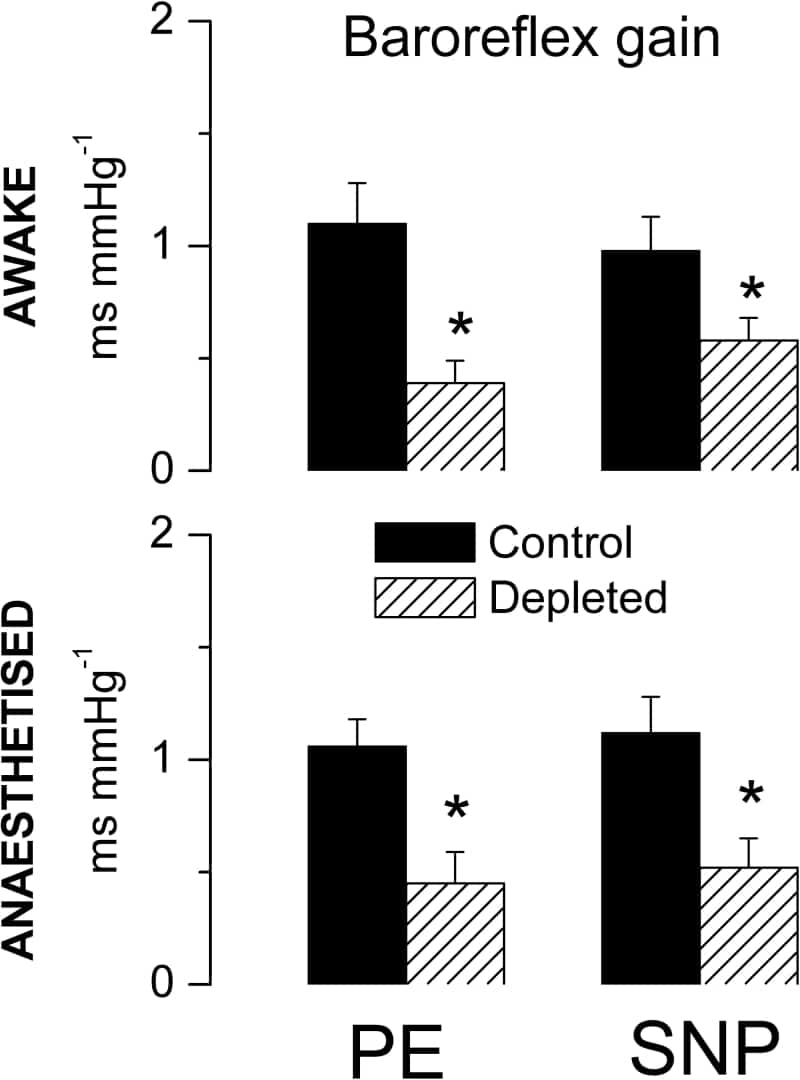Blockade of central 5-HT7 and 5-HT1A receptors interferes with reflex-evoked vagal bradycardias (Kellett et al. 2005) implying that 5-HT is released during the reflex activation of cardiac vagal preganglionic neurones. This is supported by the observation that 5-HT depletion inhibits reflex-evoked vagal bradycardias in anaesthetised rats (Kellett et al. 2004). The present experiments examine the effect of 5-HT depletion with para-chlorophenylalanine (p-CPA; Koe & Weissman, 1966) on the baroreflex of awake and subsequently anaesthetised (α-chloralose 80 mg kg-1, i.v.) rats. Adult male Sprague-Dawley rats (300-350 g) were given daily p-CPA (350 mg kg-1 s.c.; n = 7) or saline (n = 7) for 2 days. Catheters were implanted in the femoral artery and vein under isoflurane anaesthesia (2.5% in O2) 24 h before the experiment. During the experiment animals were given atenolol (1 mg kg-1, i.v.). Baroreflexes were elicited by i.v. phenylephrine (PE, 1 μg) and sodium nitroprusside (SNP, 1 μg). Absolute changes in MAP and pulse interval (PI) were measured, and reflex gain calculated by linear regression (Su et al. 1992). At the end of the experiment animals were humanely killed with an overdose of pentobarbitone. 5-HT immunocytochemistry showed a marked reduction in 5-HT immunoreactive fibres within the nucleus tractus solitarius of p-CPA treated rats. Measurement of tissue monoamine content, using HPLC (Géranton et al. 2004), confirmed that p-CPA depleted hindbrain tissue of 5-HT (mean±S.E.M.: 0.2±0.1 vs. 3.1±0.6 μM; t test, P<0.01, n = 3), but not of noradrenaline or dopamine. Baseline MAP was significantly higher in depleted vs. control rats (110±4 vs. 97±4 mmHg; 2-way ANOVA, P<0.05), but this difference was abolished by anaesthesia (71±5 vs. 78±6 mmHg). Baseline PI was similar in all groups. PE- and SNP-evoked baroreflex gains were attenuated by depletion in both awake and anaesthetised rats (see Fig. 1). Also, PE-evoked changes in PI (another measure of reflex sensitivity) were also attenuated by 5-HT depletion (23±5 vs. 50±10 ms), and in control animals they were potentiated by anaesthesia (79±6 vs. 50±10 ms), suggesting inhibitory mechanisms are active in the awake state. The data indicate that 5-HT release is involved in the cardiac baroreflex in both awake and anaesthetised rats.
University of Bristol (2005) J Physiol 567P, C39
Oral Communications: 5-HT depletion reduces cardiac baroreflex sensitivity in awake and anaesthetised rats
Kellett, Daniel; Stanford, S Clare; Machado, Benedito H; Jordan, David; Ramage, Andrew G;
1. Physiology, University College London, London, United Kingdom. 2. Physiology, University of Sao Paulo, Ribeirao Preto, Brazil. 3. Pharmacology, University College London, London, United Kingdom.
View other abstracts by:
Figure 1. Mean (± s.e.m) baroreflex gain evoked by PE and SNP in control and 5-HT depleted awake and anaesthetised rats (n = 7). * P<0.05 (cf. control).
Where applicable, experiments conform with Society ethical requirements.

